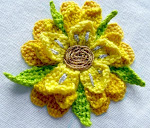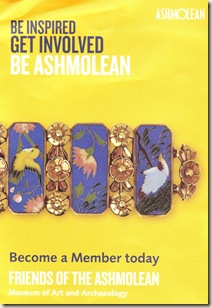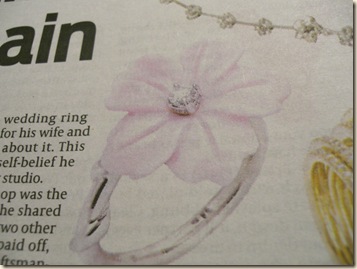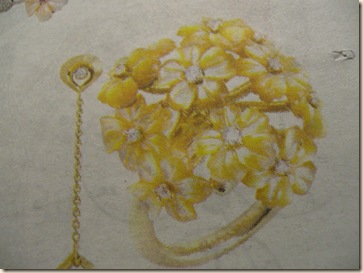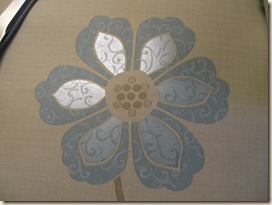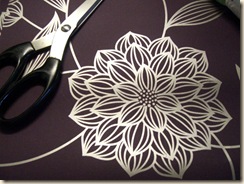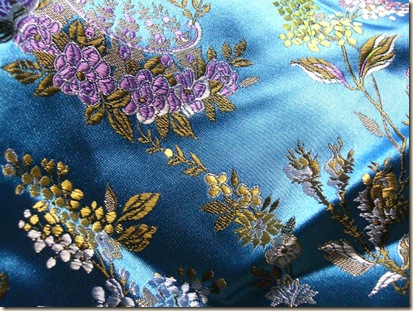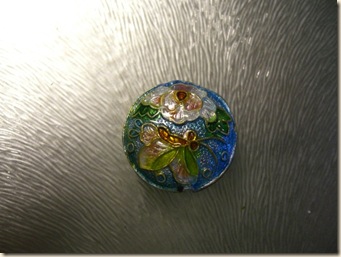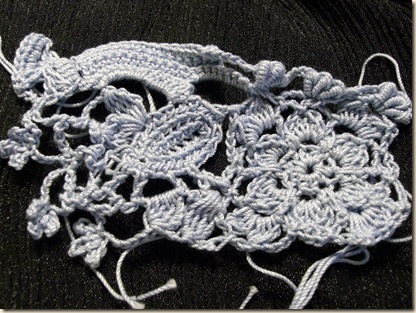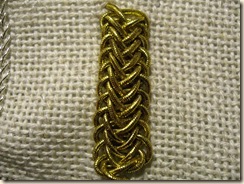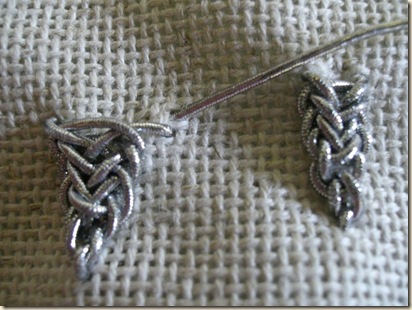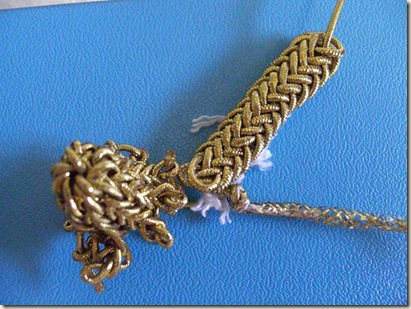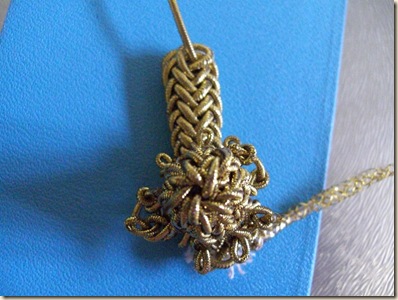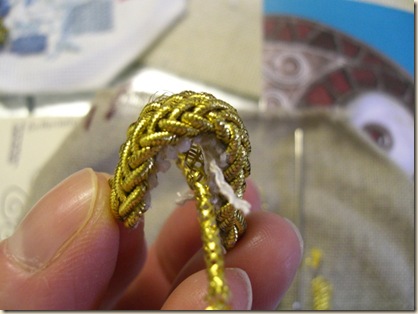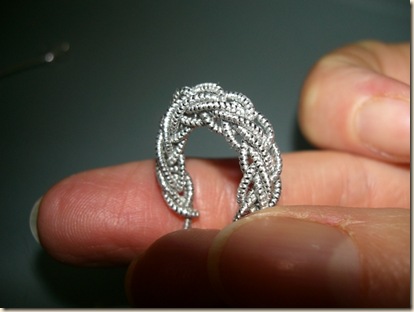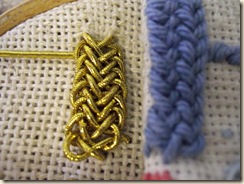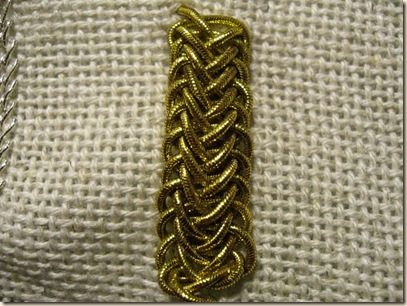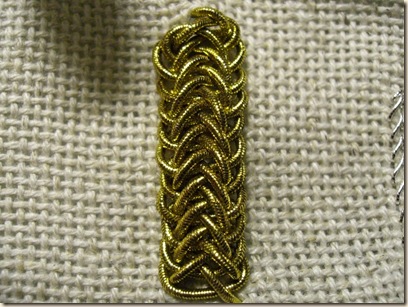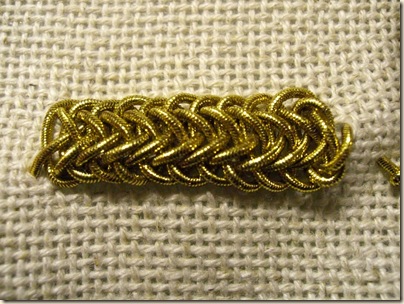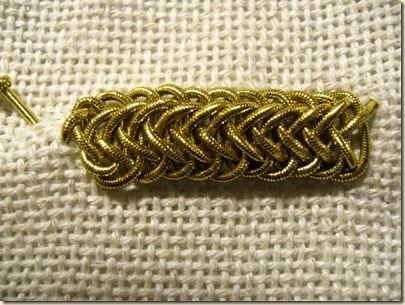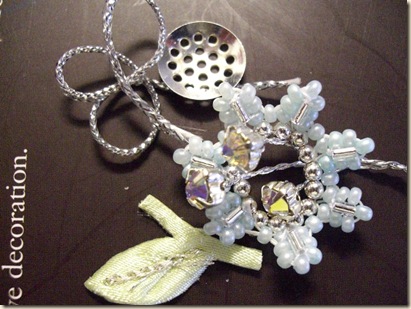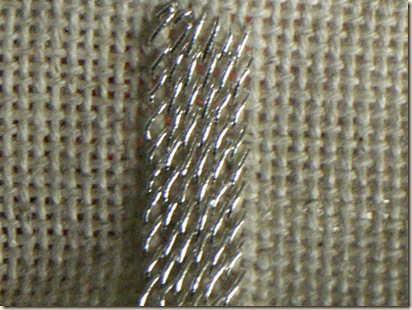(This is a longish post but lighter on text – phew!)
Suddenly things have been happening rather more quickly, however, I will need to relay them in chronological order. So, before I talk about Plaited Braid Stitch (PBS) some more, I need to explain how I got ‘there’.
First off, I visited the Ashmolean Museum in Oxford, because I happened to be there on business. I was primarily interested in seeing their new textile gallery and after that, the Saxon & Vikings section and on my way out I also saw their wonderful RINGS collection. I only had an hour to spare in there, and I was jolly hot with all my de rigueur woollies, so my notes were pretty rushed. I’ll talk about the visit some more on another occasion, especially as 2 (whole) weeks later I had to return.
This leaflet is not actually the bright yellow you can see here, but the scanner seemed to concentrate on carefully picking out the central detail of this Chinese enamelled belt. What amazing work went into that piece. I hope the actual item is on display.
For now I’ll say, The Ashmolean is a truly fantastic place and I especially like the way everything is set out; it makes a lot of sense for researching purposes, as you can compare artefacts from neighbouring countries easily and are able to thereby plot the progression and eventual cross-pollination of ideas very clearly. I think what I like most about this museum is it reminds me so much of an antique shop that’s crammed full of stuff (yummy), rather than, say, a sepulchral, minimalist ‘temple’ to the high art of days of old.
So the following weekend I managed to carve out some ‘me’ time and get a few ideas down from digging around in my stash and pouring over clippings of some gorgeous flower rings that had appeared recently in the press:
I also pulled out two new(ish) book purchases:
I’ve yet to really study the Tracy Franklin book above, it looks utterly delicious but I have to admit, my hands do tremble a little when I dip into the feast that is: The Beader’s Floral by Liz Thornton & Jill Devon:
I bought this the last time I was in Brighton (did I mention how much I love Brighton ??- lol). (Psst: don’t think about it, just get it! – not what I would call ‘a beginners book’ but who cares, if you borrow Beader’s Bible from the library and read it in conjunction, then its not so difficult – the ideas in here are the stuff of dreams !)
Then I went to my stash of ‘visuals’ and dug out some other cute things to get the creative cogs turning; like these wallpaper samples. They’re very clear jumbo designs that would easily translate into 3-d and notice how they feature a lot of silver:
Coz remember, the ring has to be silver…
and more irresistible Brighton finds… I sourced this in a wonderful old rusty-door-handle-Aladdin's Cave-of-a- shop…very nice people, fought their way to the back for me to wrench out this man-made vision…
Would you just look at this terribly pretty Chinese bead that I bought at the Covent Garden Bead shop in the Summer. I kind of thought at this stage of my ‘rummagings’ that I would ‘maybe use this bead as a colour reference’?? Its much prettier in the flesh by the way...
Then I got out a piece of my freeform crochet that I did a couple of years back. I tend to use it now as a construction-reference-sampler-thingy. I didn’t originally use a pattern for this piece, as I was just trying to replicate an embellishment detail I had glimpsed on a lovely dress in Monsoon. The dress was way out of my price range, but the small crocheted panel was something I had to ‘possess’…
Then I got to work drawing and turning ideas over in my mind and stringing up some herringbone stitch blue and silver beads and stuff, including the sweet miniature silky leaf ribbon they sell in the scrapbooking section of my LYS:
This is what I ended up with, when I stopped and thought: ‘I would really like to add some PBS petals’…
Now to wind back a bit, as I said, because of what I had gleaned from Jacqui Carey’s book (see last post) I found I was able to manipulate the overall shape of the PBS from this:
to this, by altering the beginning of the stitch to a single chain…and as you can tell, things are starting to go in a totally different direction…
At this stage my thinking was that I would probably use this triangular shape of PBS and the supporting fabric and then just cut it all out and somehow form a little petal shape for the ring..
So I cut the earlier section of PBS out, together with its gold Acorn brother that you can see here, and started to manipulate them to make them look more like components of a ring… Then I forgot about the ring entirely and started to really STARE at what was happening to the 3-d PBS…
That was when I made the first of my discoveries. By moving it around and trying to get it to look like a petal I arrived at this…
Above you can see the section of PBS is not only flexible but in so doing, IT DOES NOT UNRAVEL !….Now you might think that the remains of the linen was probably still holding it together, but let me tell you, immediately after this photo was taken, I actually pulled all the linen fragments out and it still didn’t unravel.
Then I remembered something I had read in Jacqui Carey’s Sweet Bags book:
“Plaited Braid stitch reminds me of a 4-twill braid…”
With this idea (remember, I know very little about braid-making except what I saw at Kentwell Hall – see earlier post) the ‘explorer’ in me married up this ‘notion’ of an actual braid, together with what I had learned about the Vikings making their upside-down Ceylon stitch wire knitting round a rod or support (can you see where I am headed?)….
….and I produced this:
This is a completely 3-d ‘braid’ made out of Plaited Braid Stitch that was not stitched onto background fabric first but instead, incorporated a Viking construction method.
It is the same on all 4 sides, it is square-shaped; even & extremely flexible..
(Didn’t I tell you this would make you sit bolt upright !)
This is NOT all, next time I’ll show you how I made it and what that led to….!
cya !

